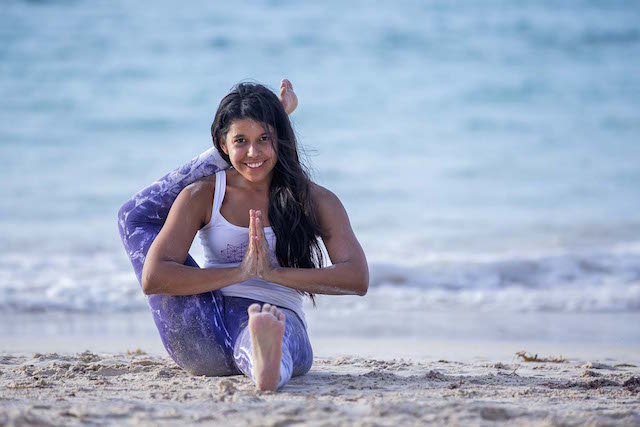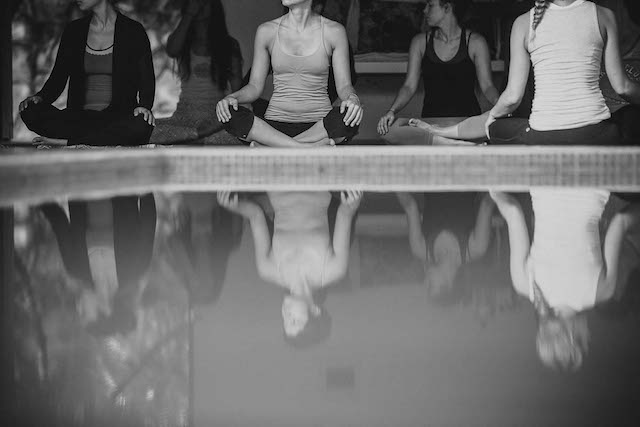I have to confess, I was scared during my first Mysore practice.
Can you imagine a yoga “class” in complete silence, where the teacher does not lead the practice, but simply observes the practitioners and adjusts postures when necessary? A class where the teacher doesn’t demonstrate the poses—and even worse, every student goes at their own pace?
Scary!
My first impression was a weird room full of sweaty bodies breathing in a strange way. No music. Really, nothing seemed to be happening; it was like being a stranger in a scary world.
It’s amazing to remember the way I judged so many things because I was a stranger in this completely new way of practicing yoga. It felt selfish, and I felt left alone. My comfort zone was colorful shalas, lovely music, candles, and super-smiley, flexible teachers practicing on their mats—a completely different story.
With this so-called “Mysore style,” I had to leave my practice in dreamland on the side.
However, after several months reflecting upon my Mysore experience, my heart sensed a unique attraction to the mysterious melody created by the breath known as Ujjayi Pranayama. I was ready to embark on a passionate long-term journey. I found it inspiring to sense a pure silence that allowed my practice to transform into a moving meditation. Something powerful was happening—in a collective manner, but with each of us moving at our own pace facing our own battles.
A great number of Ashtangis have probably gone through similar experiences, but my guess is that only the lucky curious and faithful discover the truth that lies within it. I narrate this story over and over to inspire others to give it a try and maybe find their own path.
It is crucial to understand the tools used in the practice: first, Ujjayi breath; second, the Bandhas (Mula, Uddiyana, Jalandhara), translated into energetic locks or the breaks of the dynamic flow; third, the Drishti or focal point for each pose that helps us in attaining deeper concentration and eventually reaching a meditative state.
Today I feel thrilled to be writing this article and flashing back to that pivotal moment of feeling scared at my first Mysore practice. Five years have passed already, and I feel excited to keep embracing my Mysore practice in a gradual approach under the guidance of my teachers Linda Munro and Gérald Disse.

Here are my top 10 tips for exploring a Mysore practice:
1. Don’t be afraid. But ask your teacher whether you can start the Mysore practice. Each school has different “rules” and it is important to respect them.
2. Ask for a “cheat sheet” of the sequence and put it next to your mat while you memorize it.
3. Be patient, be prepared to be a beginner, and enjoy the step-by-step process.
4. Trust the teacher. Every school is different, but the Ashtanga Yoga method always stays the same.
5. Don’t take a water bottle inside the shala. Different from doing exercise, yoga is intended to build up our endurance to not drinking water during practice. We’re stimulating an internal fire (agni), which detoxifies our body and mind.
6. Stay at your own pace and in your own practice, don’t copy or compare to what others are doing.
7. Don’t ask what pose is next. As you become more disciplined in the practice your body will completely transform. You’ll develop the strength and flexibility needed for the upcoming poses and your teacher will be aware of that.
8. Take a long savasana.
9. Cut off your thoughts to cultivate inner silence. The practice is intended for self-introspection.
10. Enjoy it and smile while nurturing immense love and compassion for yourself.
Starting a Mysore practice is a brave, long journey. Practicing and teaching Ashtanga yoga continues to be an essential part of my life. It is a beautiful tool for self-introspection, self-care and love. I believe the Mysore practice has a revolutionary power to transform our inner worlds to the best of our abilities.
As in the scary Mysore practice, it is up to each and every one of us to take full responsibility—not only on the mat, but beyond it too. We must fulfill our own duty without waiting for the collective push. Our world is suffering, as we all do, and by doing our self-practice and working on our own shadows, we are acting to gradually change the flow of our collective unconsciousness.
Let’s plant seeds of consciousness, love and compassion in our own hearts. Let’s allow ourselves to be strangers in this world and gradually find our own balanced state.
~
Author: The Global Yogini
Images: Courtesy of author via Yala Collective and Camilo Duque
Editor: Toby Israel
~


 Share on bsky
Share on bsky





Read 0 comments and reply